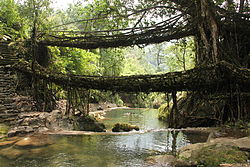
Living root bridges are a kind of tree shaping in which rivers are spanned by architecture formed out of the roots of ficus plants. Due to their being made from living, growing, trees, they "show a very wide variety of structural typologies, with various aspects of particular bridges resembling characteristics of suspension bridges, cable-stayed bridges, arches, trusses, and simply-supported beams."[1] They are common in the Indian state of Meghalaya.
The structures are handmade from the aerial roots of rubber fig trees (Ficus elastica[2][3]) by the Khasi and Jaiñtia[4][5] peoples of the mountainous terrain along the southern part of the Shillong Plateau. Most of the bridges grow on steep slopes of subtropical moist broadleaf forest between 50 and 1,150 m (160 and 3,770 ft) above sea level.[6]
As long as the tree from which it is formed remains healthy, the roots in the bridge can naturally grow thick and strengthen. New roots can grow throughout the tree's life and must be pruned or manipulated to strengthen the bridge. Once mature, some bridges can have as many as 50 or more people crossing, and have a lifespan of several hundred years.[7][8] Without active care, many bridges have decayed or grown wild, becoming unusable.[9] Written documentation of living root bridges was sparse until the 2010s, but in 2017, researchers geo-located a total of 75 living root bridges.[10]
Living root bridges have also been created in the Indian state of Nagaland,[11] in Indonesia at Jembatan akar on the island of Sumatra, and in the Banten province of Java, by the Baduy people.[12]
- ^ Ludwig, Ferdinand; Middleton, Wilfrid; Gallenmüller, Friederike; Rogers, Patrick; Speck, Thomas (22 August 2019). "Living bridges using aerial roots of ficus elastica – an interdisciplinary perspective". Scientific Reports. 9 (1): 12226. doi:10.1038/s41598-019-48652-w. ISSN 2045-2322. PMC 6706416.
- ^ Lewin, Brent (November 2012), "India's living Bridges", Reader's Digest Australia, pp. 82–89, archived from the original on 16 November 2012
- ^ "Living Root Bridge in Laitkynsew India". www.india9.com. Retrieved 22 February 2010.
- ^ Reporter, By Our (21 November 2011). "End of Khasi-Pnar benevolence". The Shillong Times. Retrieved 30 March 2024.
- ^ Ludwig, Ferdinand; Middleton, Wilfrid; Gallenmüller, Friederike; Rogers, Patrick; Speck, Thomas (22 August 2019). "Living bridges using aerial roots of ficus elastica – an interdisciplinary perspective". Scientific Reports. 9 (1): 12226. doi:10.1038/s41598-019-48652-w. ISSN 2045-2322. PMC 6706416.
- ^ Ludwig, Ferdinand & Middleton, Wilfrid & Gallenmüller, Friederike & Rogers, Patrick & Speck, Thomas. (2019). Living bridges using aerial roots of ficus elastica – an interdisciplinary perspective. Scientific Reports. 9. 10.1038/s41598-019-48652-w.
- ^ Ludwig, Ferdinand; Middleton, Wilfrid; Gallenmüller, Friederike; Rogers, Patrick; Speck, Thomas (22 August 2019). "Living bridges using aerial roots of ficus elastica – an interdisciplinary perspective". Scientific Reports. 9 (1): 12226. Bibcode:2019NatSR...912226L. doi:10.1038/s41598-019-48652-w. ISSN 2045-2322. PMC 6706416. PMID 31439904.
- ^ Chithra, K.; Krishnan, K. Amritha (2015). Implementing Campus Greening Initiatives. Switzerland: Springer International Publishing. pp. 113–124. ISBN 978-3-319-11960-1.
- ^ Middleton, Wilfrid & Habibi, Amin & Shankar, Sanjeev & Ludwig, Ferdinand. (2020). Characterizing Regenerative Aspects of Living Root Bridges. Sustainability. 12. 10.3390/su12083267.
- ^ Middleton, Wilfrid; Habibi, Amin; Shankar, Sanjeev; Ludwig, Ferdinand (17 April 2020). "Characterizing Regenerative Aspects of Living Root Bridges". Sustainability. 12 (8): 3267. doi:10.3390/su12083267. ISSN 2071-1050.
- ^ "Living Root Bridges of Nagaland India – Nyahnyu Village Mon District | Guy Shachar". guyshachar.com. Retrieved 7 September 2017.
- ^ Grundhauser, Eric, WEST SUMATRA, INDONESIA Jembatan Akar, Atlasobscura
